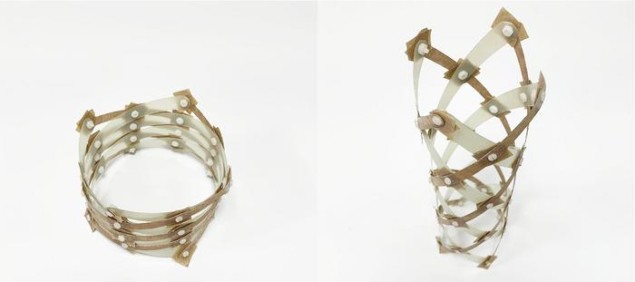
A lightweight, easily transportable antenna that can communicate reliably with either satellites or terrestrial devices depending on its spatial configuration could prove useful for coordinating disaster relief efforts. The helix-based device, which resembles a child’s finger-trap toy, switches between its two operating modes as it is extended and contracted and could also be deployed in space or in areas that currently lack good communications infrastructure.
Developed by researchers at Stanford University in the US and the American University of Beirut (AUB) in Lebanon, the new antenna has a mass of just 39 g and consists of counter-rotating helical strips that are connected by rotational joints and made from polymer fibre composites containing a conductive mesh. In its shortened configuration, it resembles a ring just over 2.5 cm thick and 12 cm across and can be used for targeted satellite communications. When extended, it forms a thin cylinder about 30 cm tall that sends signals in all directions, like a WiFi router. This adaptability is crucial for post-disaster search and rescue operations, explains Joseph Costantine, an electrical and computer engineer at AUB who co-led the antenna’s development together with Stanford aerospace engineer Maria Sakovsky.
When deployed, the antenna is mounted on a custom ground plane that reflects radio waves while allowing the antenna base to slide and change shape. It is stable in each of its configurations, and can be switched between them simply by pulling or pushing on it, with no need for electrical power. It can also be connected to a transceiver (for sending and receiving signals), a laptop and other electronics to make a complete package with a mass of about 1 kg. This is much less than the metallic dishes typically employed in disaster-struck areas, which weigh in at around 20 kg and require a lot of power to operate.
Lightweight and compact
The antenna’s small size and low mass mean that it might also be used in space, where fuel and cargo limitations mean that everything needs to be as light and compact as possible. It could, for example, replace multiple antennas on a satellite with a single one, Sakovsky says.

The future of flying antennas
Looking forward, the researchers aim to broaden their focus to include multi-stable structures with hundreds of operating states, not just two, leveraging their properties to pioneer the development of morphing, intelligent surfaces. “These will be able to dynamically steer electromagnetic beams to alter wave polarization, for instance,” Costantine tells Physics World. “Our goal is to extend the reach of signals emitted by such antennas, enabling faster data rates and more efficient communication schemes with minimal power requirements and enhanced adaptability.”
The antenna’s design is described in Nature Communications.



